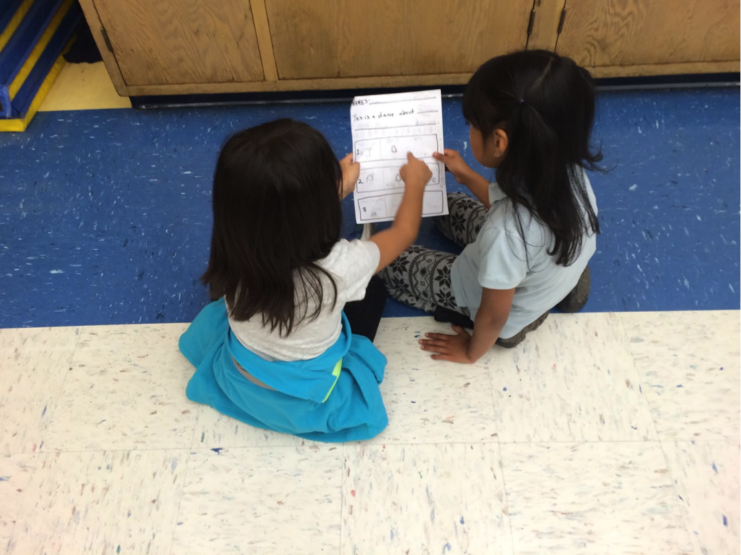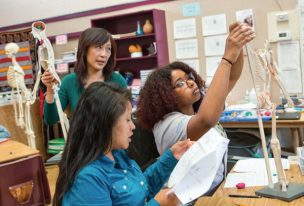
Arts Integration and Literacy: A Powerful Combination for ELLs
I’ve invited five of my first-grade students to join me for lunch in our classroom. In this group are two native English speakers and three English Language Learners (ELLs), a ratio which is reflective of the school population. We’re sitting at a classroom table, looking at videos taken during the creative dance class we just finished about a half hour ago, taught by a dance educator from the Luna Dance Institute. The kids are excited because they are the stars of the movie they’re watching! I ask them to describe what they see.
Liz: I saw Kyle spinning around Zara and he was doing this (gestures with arms wide).
Antonio: I see Zara doing a shape and Kyle doing like this (gestures turning and going backwards).
Teacher: Now this time, I want you to think as dancers and use dance words.
Liz: He’s bowing and spreading his arms wide.
Jori: I think that was like a bird.
Teacher: Do you think that was what he wanted to do? Can you use any dance words?
Jori: Smoothing.
Jessica: Loose.
Elodie says, “She’s moving like a little slug, like a little caterpillar.” Elodie’s an ELL, and she’s struggling to find the words, but she’s using her body to show the way an inchworm folds itself and then expands forward. The others supply some more ideas: “bursting,” “falling,” “twirling,” “balancing.” When they’re finished eating, we move to the classroom rug and I ask them to show me some of the moves they saw each other making in the video. They happily demonstrate for me, reenacting each other’s creative explorations.
I listen to the recording of this lunchtime conversation on my way home. I’m hearing the kids’ processing in a new way, when I have the luxury of not managing the class or thinking about the next step, but just listening to them. While their language is imprecise, they’re noticing details about each other’s dancing that I didn’t appreciate because I was so focused on whether or not they could use the specific vocabulary. I’ve kept these recordings of lunch conversations with my students on my phone for months now, because every time I listen to them, I hear something I hadn’t noticed before. I keep thinking about the value of teaching dance, and the ways that the arts can support a child’s emerging literacy. This is the type of powerful arts integration that I was able to understand and apply in my classroom, thanks to my inquiry with Mills Teacher Scholars –arts integration that I had always supported, but for a long time had not worked to fully leverage.
A Bit of Background
I’ve been teaching kindergarten and first grade in this East Oakland public school for ten years. It’s not an easy neighborhood to be a child in — violence and poverty are parts of many students’ lives. The school has no PTA to fill in the gaps and provide enrichment classes. So it’s remarkable that every student in the school participates in creative dance for at least half of the year.
For years, on the day of our dance class, I duly delivered my students to the dance room (yes, we have a dedicated dance room!) and spent the next 50 minutes standing on the sides, occasionally stepping in to help the dance teacher keep the kids from being completely out of control and sliding all over the open floor. Each time we left the dance room, we moved onto the next item on our agenda without another thought. With a full roster of district curriculum requirements and a packed weekly instructional schedule, I just didn’t have the bandwidth to add something that felt “optional” to the students’ full plate.
In recent years I started to see the dance teacher as a partner instead of a provider of a service for students. I began to make connections between what my students were experiencing in dance and what we do in class. I started to explore ways to keep students thinking about dance during the days when we did not have the class. During the summer of 2015, I was fortunate to be able to attend attended the Luna Summer Dance Institute, which increased my interest in arts integrated learning. It reminded me of how important it is that young children get to move and express themselves, and that they be given the safe and supportive setting to be creative risk takers.
The Inquiry
The inquiry focus area came easily to me this year: exploring literacy through dance. How does creative dance support students and their learning? I know that arts integration is important, but I’m not sure how to accomplish it. How can students use communication skills (writing, speaking, listening, and observing) to process and describe their experience of dance? In addition to describing something they experienced, can they use these skills to compose and plan a future dance experience?

These first-grade dance partners have written their plan for a new dance and are now planning their sequence.
The inquiry took me along a rich spiral of talking, recording, and learning from my students, a snapshot of which I describe above. We explored writing through dance journaling. I also interviewed students about photographs of other dancers. Then I started taking photographs and videos of my students during dance class. In talking about these recordings with my colleagues, I soon realized that I wanted to record their comments about the photos and videos of themselves. I invited small groups of students to have lunch with me, to look at the pictures and watch the videos I had taken. I recorded these conversations and afterwards, we would listen to their conversations about dance together.
Through the inquiry process I found ways to layer additional experiences on top of the foundational dance experiences my students had just had. A six-year-old child doesn’t always understand what you mean if you ask, “How do you know?” (a common thread in the Common Core), but I was beginning to sense how validating it was for my students to literally see themselves as artists engaged in a creative process, and then to listen to themselves talk about their experiences. They could discover their own thinking by experiencing the dance and the conversation about it again and generate increasingly rich language. Throughout this process, I recorded what they said, took notes, and listened again and again to try to understand what learning was taking place and what was valuable to my students so I could build on that.
The Time, Structure and Support for Guided Reflection
Just as our students’ minutes are all scheduled and accounted for with required minutes for reading, writing, and math, my teacher time is also taken up with planning for these curriculum areas. I start to panic when I feel that I’m getting behind and not keeping up with the district pacing and assessment schedule. Mills Teacher Scholars provided me with the time and support to focus not only on reading levels, writing products, and rubrics, but also the value of speaking, listening, viewing and reflecting on learning through the arts. Teachers and students alike need to engage and persist in activities that don’t have a right or expected answer, and be given structured opportunities to think about and process these experiences. To see ourselves as actors and experimenters is both empowering and validating.
After receiving her teaching credential at Mills, Emily Blossom started teaching in East Oakland in 2006, and has been teaching kindergarten and first grade at New Highland Academy ever since. She was National Board Certified in 2012. Emily still loves the joys and surprises of working with young children, and loves to apply an inquiry mindset to her teaching life.


